Information Literacy: A Critical Skill for Nursing University Students
VerifiedAdded on 2020/05/11
|8
|1653
|134
Essay
AI Summary
This essay delves into the crucial role of information literacy for nursing students, emphasizing its importance in navigating online resources and academic research. The essay defines information literacy as the ability to recognize, locate, evaluate, and effectively use information. It highlights the necessity of this skill within the context of nursing education, especially given the reliance on electronic resources like e-libraries. The essay examines the evolution of information literacy, tracing its roots to the 1970s and its growth with the internet. It discusses the impact of information literacy on students' ability to find credible sources, assess data, and avoid misinformation. Furthermore, the essay explores various search methods used in the past decade, such as doctrinal and social-legal approaches, as well as the use of online search engines. It concludes by reinforcing the significance of information literacy as a fundamental skill for nursing students, supporting evidence-based practices and academic success.
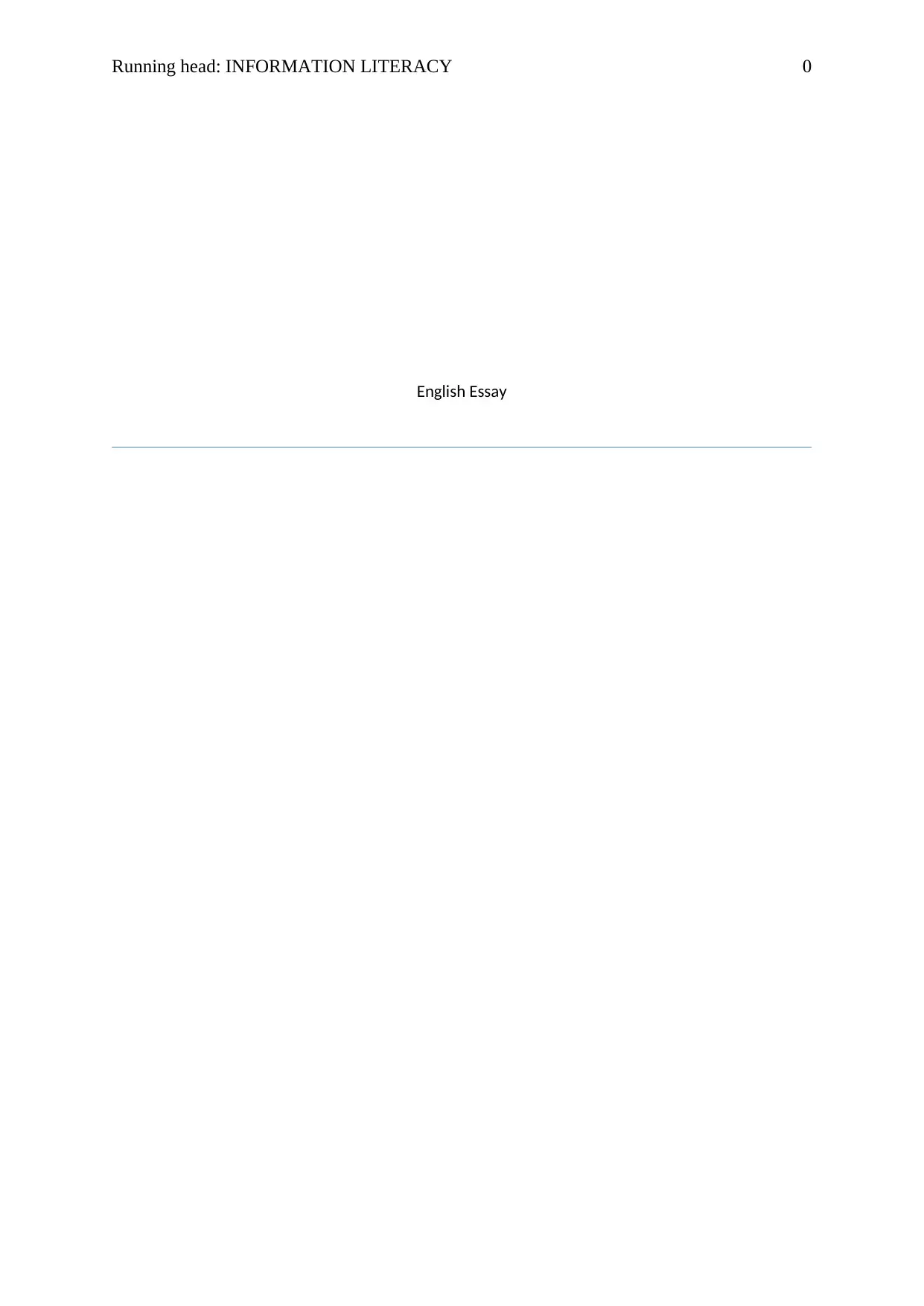
Running head: INFORMATION LITERACY 0
English Essay
English Essay
Paraphrase This Document
Need a fresh take? Get an instant paraphrase of this document with our AI Paraphraser
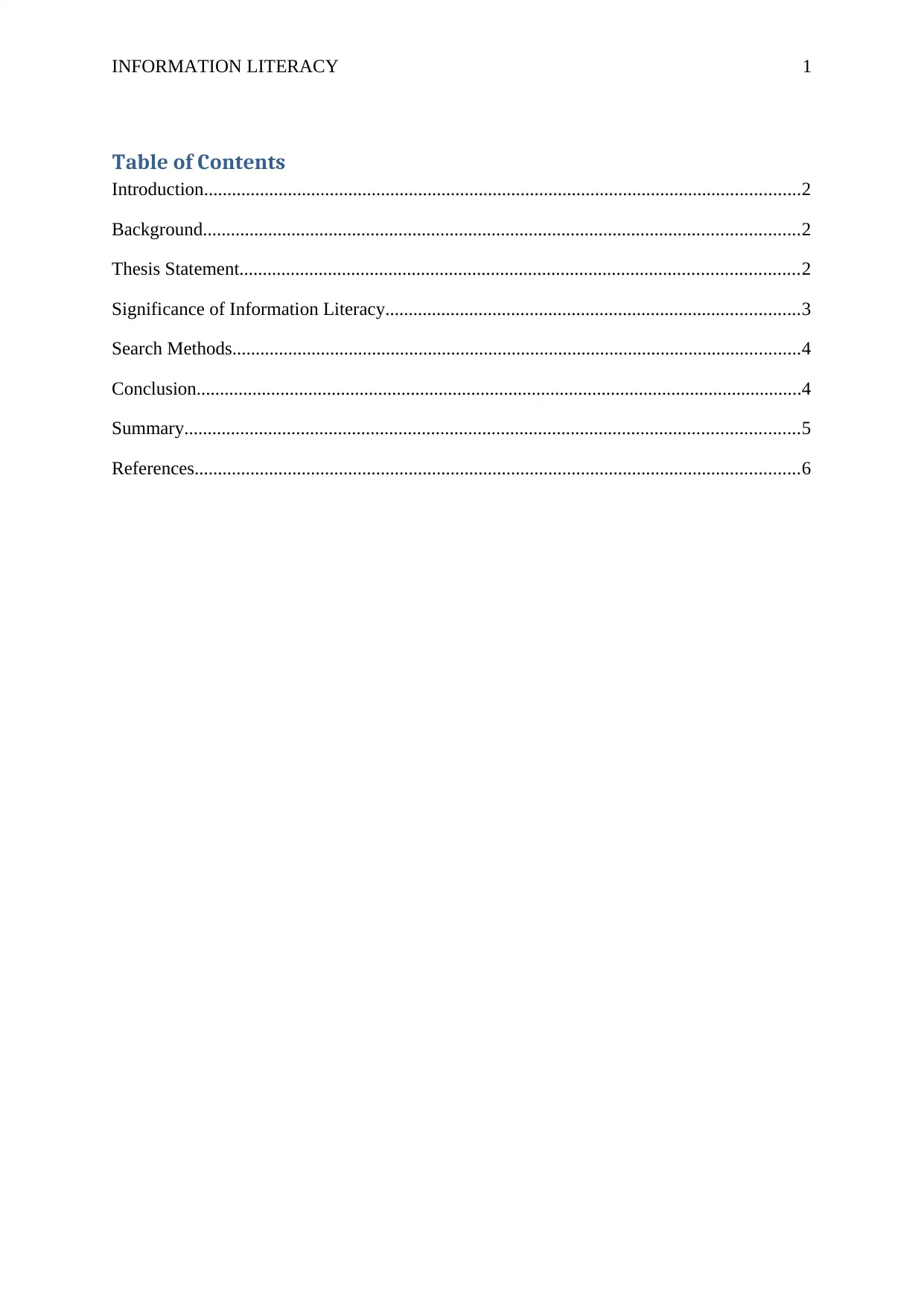
INFORMATION LITERACY 1
Table of Contents
Introduction................................................................................................................................2
Background................................................................................................................................2
Thesis Statement........................................................................................................................2
Significance of Information Literacy.........................................................................................3
Search Methods..........................................................................................................................4
Conclusion..................................................................................................................................4
Summary....................................................................................................................................5
References..................................................................................................................................6
Table of Contents
Introduction................................................................................................................................2
Background................................................................................................................................2
Thesis Statement........................................................................................................................2
Significance of Information Literacy.........................................................................................3
Search Methods..........................................................................................................................4
Conclusion..................................................................................................................................4
Summary....................................................................................................................................5
References..................................................................................................................................6
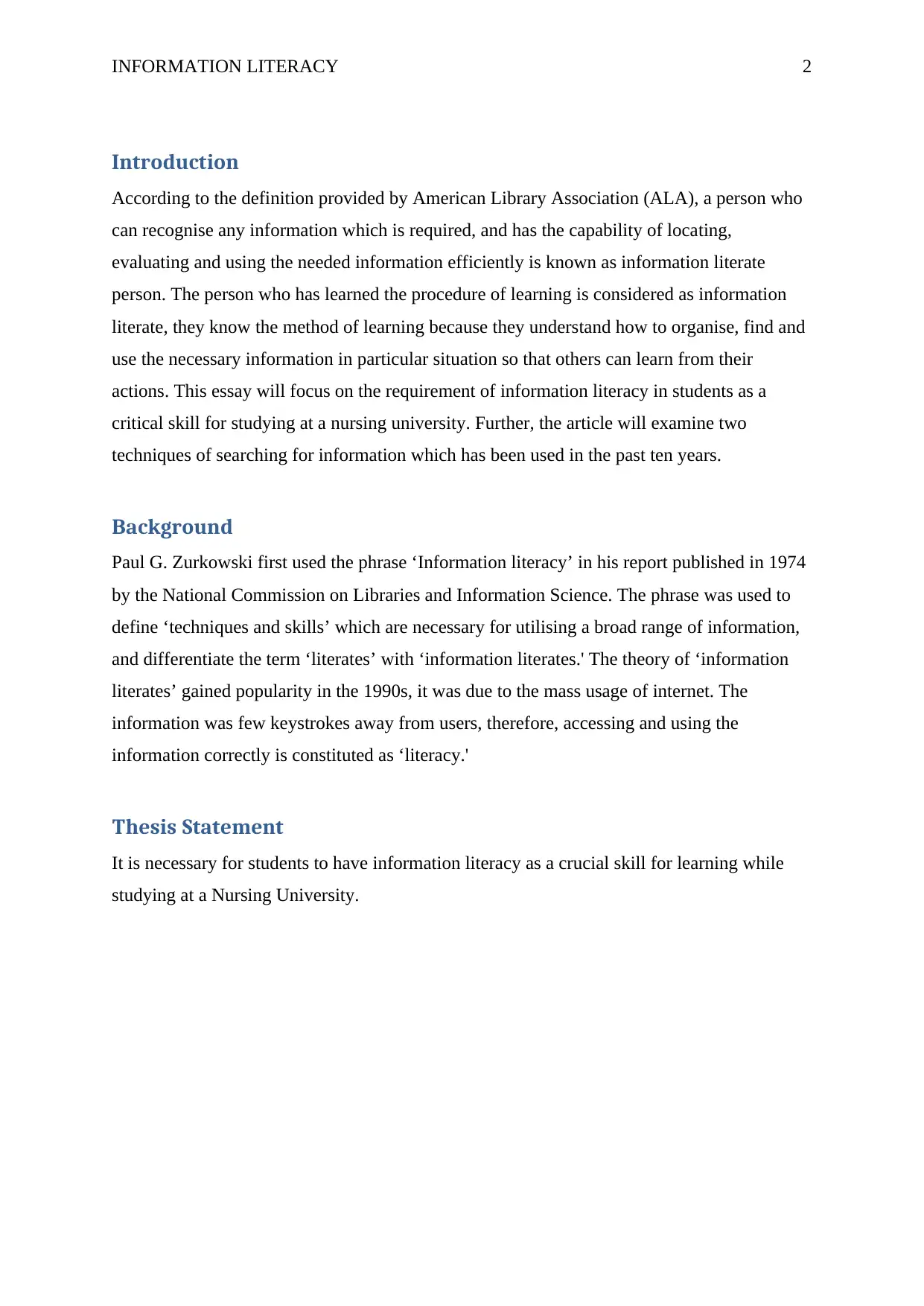
INFORMATION LITERACY 2
Introduction
According to the definition provided by American Library Association (ALA), a person who
can recognise any information which is required, and has the capability of locating,
evaluating and using the needed information efficiently is known as information literate
person. The person who has learned the procedure of learning is considered as information
literate, they know the method of learning because they understand how to organise, find and
use the necessary information in particular situation so that others can learn from their
actions. This essay will focus on the requirement of information literacy in students as a
critical skill for studying at a nursing university. Further, the article will examine two
techniques of searching for information which has been used in the past ten years.
Background
Paul G. Zurkowski first used the phrase ‘Information literacy’ in his report published in 1974
by the National Commission on Libraries and Information Science. The phrase was used to
define ‘techniques and skills’ which are necessary for utilising a broad range of information,
and differentiate the term ‘literates’ with ‘information literates.' The theory of ‘information
literates’ gained popularity in the 1990s, it was due to the mass usage of internet. The
information was few keystrokes away from users, therefore, accessing and using the
information correctly is constituted as ‘literacy.'
Thesis Statement
It is necessary for students to have information literacy as a crucial skill for learning while
studying at a Nursing University.
Introduction
According to the definition provided by American Library Association (ALA), a person who
can recognise any information which is required, and has the capability of locating,
evaluating and using the needed information efficiently is known as information literate
person. The person who has learned the procedure of learning is considered as information
literate, they know the method of learning because they understand how to organise, find and
use the necessary information in particular situation so that others can learn from their
actions. This essay will focus on the requirement of information literacy in students as a
critical skill for studying at a nursing university. Further, the article will examine two
techniques of searching for information which has been used in the past ten years.
Background
Paul G. Zurkowski first used the phrase ‘Information literacy’ in his report published in 1974
by the National Commission on Libraries and Information Science. The phrase was used to
define ‘techniques and skills’ which are necessary for utilising a broad range of information,
and differentiate the term ‘literates’ with ‘information literates.' The theory of ‘information
literates’ gained popularity in the 1990s, it was due to the mass usage of internet. The
information was few keystrokes away from users, therefore, accessing and using the
information correctly is constituted as ‘literacy.'
Thesis Statement
It is necessary for students to have information literacy as a crucial skill for learning while
studying at a Nursing University.
⊘ This is a preview!⊘
Do you want full access?
Subscribe today to unlock all pages.

Trusted by 1+ million students worldwide
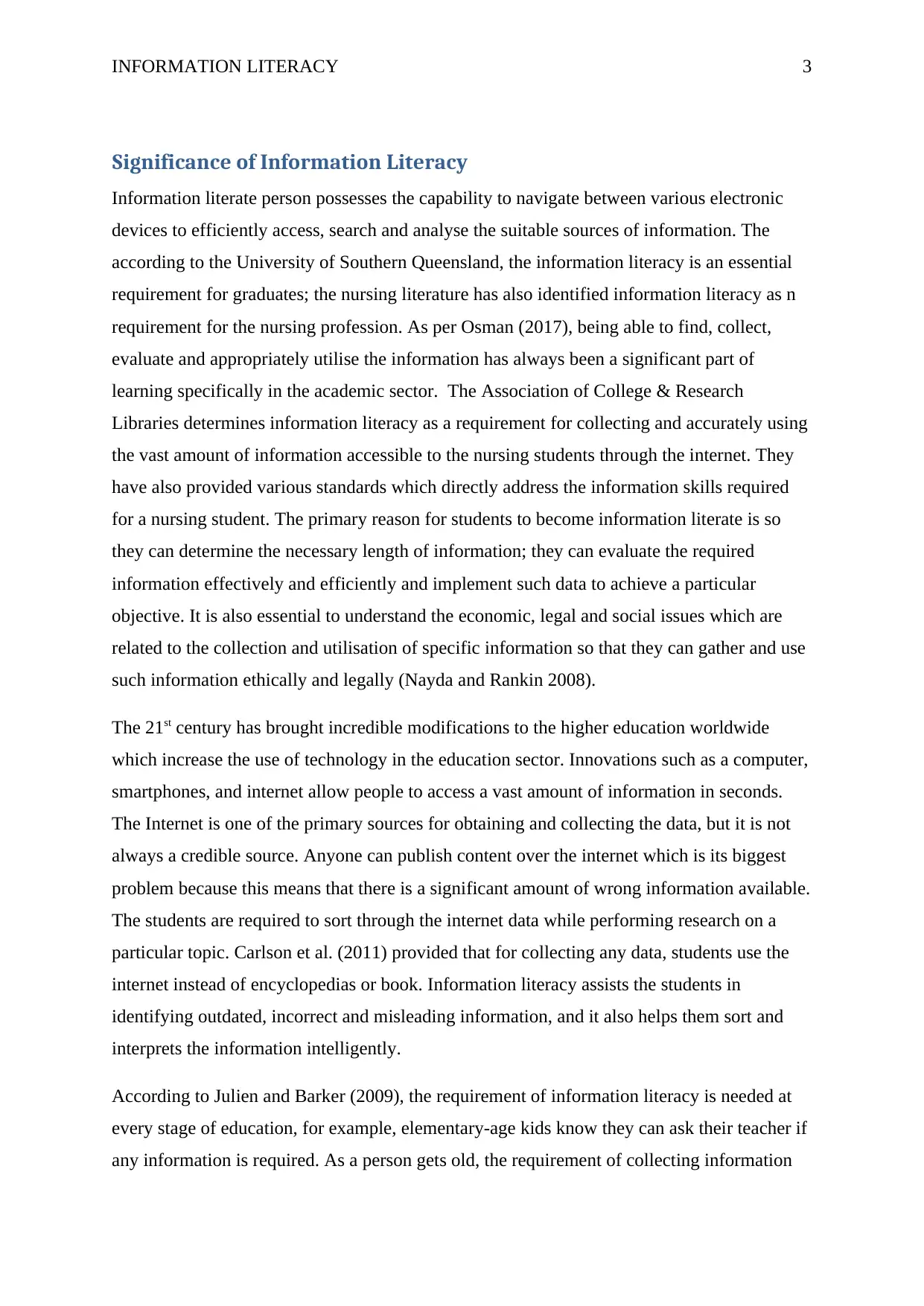
INFORMATION LITERACY 3
Significance of Information Literacy
Information literate person possesses the capability to navigate between various electronic
devices to efficiently access, search and analyse the suitable sources of information. The
according to the University of Southern Queensland, the information literacy is an essential
requirement for graduates; the nursing literature has also identified information literacy as n
requirement for the nursing profession. As per Osman (2017), being able to find, collect,
evaluate and appropriately utilise the information has always been a significant part of
learning specifically in the academic sector. The Association of College & Research
Libraries determines information literacy as a requirement for collecting and accurately using
the vast amount of information accessible to the nursing students through the internet. They
have also provided various standards which directly address the information skills required
for a nursing student. The primary reason for students to become information literate is so
they can determine the necessary length of information; they can evaluate the required
information effectively and efficiently and implement such data to achieve a particular
objective. It is also essential to understand the economic, legal and social issues which are
related to the collection and utilisation of specific information so that they can gather and use
such information ethically and legally (Nayda and Rankin 2008).
The 21st century has brought incredible modifications to the higher education worldwide
which increase the use of technology in the education sector. Innovations such as a computer,
smartphones, and internet allow people to access a vast amount of information in seconds.
The Internet is one of the primary sources for obtaining and collecting the data, but it is not
always a credible source. Anyone can publish content over the internet which is its biggest
problem because this means that there is a significant amount of wrong information available.
The students are required to sort through the internet data while performing research on a
particular topic. Carlson et al. (2011) provided that for collecting any data, students use the
internet instead of encyclopedias or book. Information literacy assists the students in
identifying outdated, incorrect and misleading information, and it also helps them sort and
interprets the information intelligently.
According to Julien and Barker (2009), the requirement of information literacy is needed at
every stage of education, for example, elementary-age kids know they can ask their teacher if
any information is required. As a person gets old, the requirement of collecting information
Significance of Information Literacy
Information literate person possesses the capability to navigate between various electronic
devices to efficiently access, search and analyse the suitable sources of information. The
according to the University of Southern Queensland, the information literacy is an essential
requirement for graduates; the nursing literature has also identified information literacy as n
requirement for the nursing profession. As per Osman (2017), being able to find, collect,
evaluate and appropriately utilise the information has always been a significant part of
learning specifically in the academic sector. The Association of College & Research
Libraries determines information literacy as a requirement for collecting and accurately using
the vast amount of information accessible to the nursing students through the internet. They
have also provided various standards which directly address the information skills required
for a nursing student. The primary reason for students to become information literate is so
they can determine the necessary length of information; they can evaluate the required
information effectively and efficiently and implement such data to achieve a particular
objective. It is also essential to understand the economic, legal and social issues which are
related to the collection and utilisation of specific information so that they can gather and use
such information ethically and legally (Nayda and Rankin 2008).
The 21st century has brought incredible modifications to the higher education worldwide
which increase the use of technology in the education sector. Innovations such as a computer,
smartphones, and internet allow people to access a vast amount of information in seconds.
The Internet is one of the primary sources for obtaining and collecting the data, but it is not
always a credible source. Anyone can publish content over the internet which is its biggest
problem because this means that there is a significant amount of wrong information available.
The students are required to sort through the internet data while performing research on a
particular topic. Carlson et al. (2011) provided that for collecting any data, students use the
internet instead of encyclopedias or book. Information literacy assists the students in
identifying outdated, incorrect and misleading information, and it also helps them sort and
interprets the information intelligently.
According to Julien and Barker (2009), the requirement of information literacy is needed at
every stage of education, for example, elementary-age kids know they can ask their teacher if
any information is required. As a person gets old, the requirement of collecting information
Paraphrase This Document
Need a fresh take? Get an instant paraphrase of this document with our AI Paraphraser
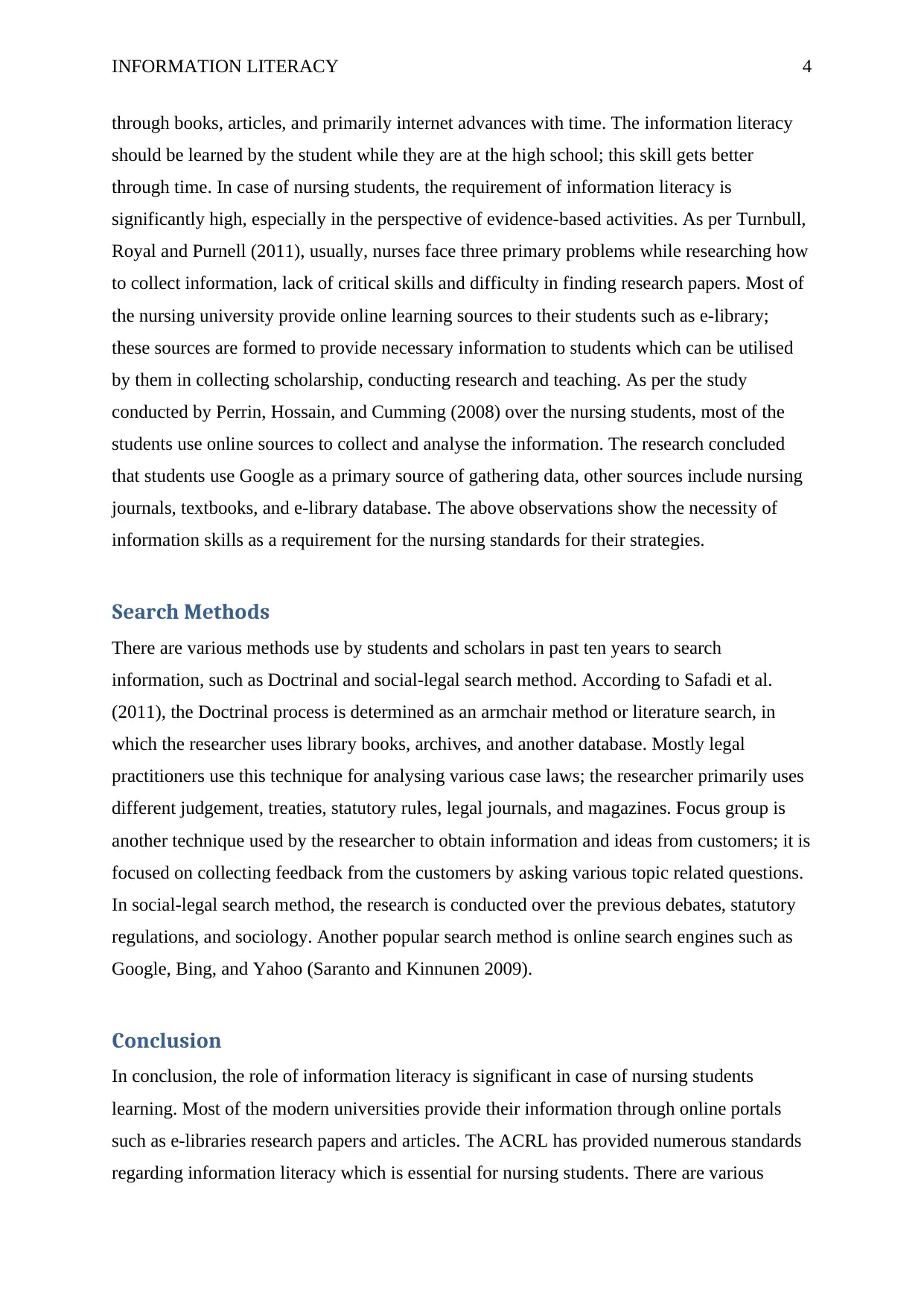
INFORMATION LITERACY 4
through books, articles, and primarily internet advances with time. The information literacy
should be learned by the student while they are at the high school; this skill gets better
through time. In case of nursing students, the requirement of information literacy is
significantly high, especially in the perspective of evidence-based activities. As per Turnbull,
Royal and Purnell (2011), usually, nurses face three primary problems while researching how
to collect information, lack of critical skills and difficulty in finding research papers. Most of
the nursing university provide online learning sources to their students such as e-library;
these sources are formed to provide necessary information to students which can be utilised
by them in collecting scholarship, conducting research and teaching. As per the study
conducted by Perrin, Hossain, and Cumming (2008) over the nursing students, most of the
students use online sources to collect and analyse the information. The research concluded
that students use Google as a primary source of gathering data, other sources include nursing
journals, textbooks, and e-library database. The above observations show the necessity of
information skills as a requirement for the nursing standards for their strategies.
Search Methods
There are various methods use by students and scholars in past ten years to search
information, such as Doctrinal and social-legal search method. According to Safadi et al.
(2011), the Doctrinal process is determined as an armchair method or literature search, in
which the researcher uses library books, archives, and another database. Mostly legal
practitioners use this technique for analysing various case laws; the researcher primarily uses
different judgement, treaties, statutory rules, legal journals, and magazines. Focus group is
another technique used by the researcher to obtain information and ideas from customers; it is
focused on collecting feedback from the customers by asking various topic related questions.
In social-legal search method, the research is conducted over the previous debates, statutory
regulations, and sociology. Another popular search method is online search engines such as
Google, Bing, and Yahoo (Saranto and Kinnunen 2009).
Conclusion
In conclusion, the role of information literacy is significant in case of nursing students
learning. Most of the modern universities provide their information through online portals
such as e-libraries research papers and articles. The ACRL has provided numerous standards
regarding information literacy which is essential for nursing students. There are various
through books, articles, and primarily internet advances with time. The information literacy
should be learned by the student while they are at the high school; this skill gets better
through time. In case of nursing students, the requirement of information literacy is
significantly high, especially in the perspective of evidence-based activities. As per Turnbull,
Royal and Purnell (2011), usually, nurses face three primary problems while researching how
to collect information, lack of critical skills and difficulty in finding research papers. Most of
the nursing university provide online learning sources to their students such as e-library;
these sources are formed to provide necessary information to students which can be utilised
by them in collecting scholarship, conducting research and teaching. As per the study
conducted by Perrin, Hossain, and Cumming (2008) over the nursing students, most of the
students use online sources to collect and analyse the information. The research concluded
that students use Google as a primary source of gathering data, other sources include nursing
journals, textbooks, and e-library database. The above observations show the necessity of
information skills as a requirement for the nursing standards for their strategies.
Search Methods
There are various methods use by students and scholars in past ten years to search
information, such as Doctrinal and social-legal search method. According to Safadi et al.
(2011), the Doctrinal process is determined as an armchair method or literature search, in
which the researcher uses library books, archives, and another database. Mostly legal
practitioners use this technique for analysing various case laws; the researcher primarily uses
different judgement, treaties, statutory rules, legal journals, and magazines. Focus group is
another technique used by the researcher to obtain information and ideas from customers; it is
focused on collecting feedback from the customers by asking various topic related questions.
In social-legal search method, the research is conducted over the previous debates, statutory
regulations, and sociology. Another popular search method is online search engines such as
Google, Bing, and Yahoo (Saranto and Kinnunen 2009).
Conclusion
In conclusion, the role of information literacy is significant in case of nursing students
learning. Most of the modern universities provide their information through online portals
such as e-libraries research papers and articles. The ACRL has provided numerous standards
regarding information literacy which is essential for nursing students. There are various
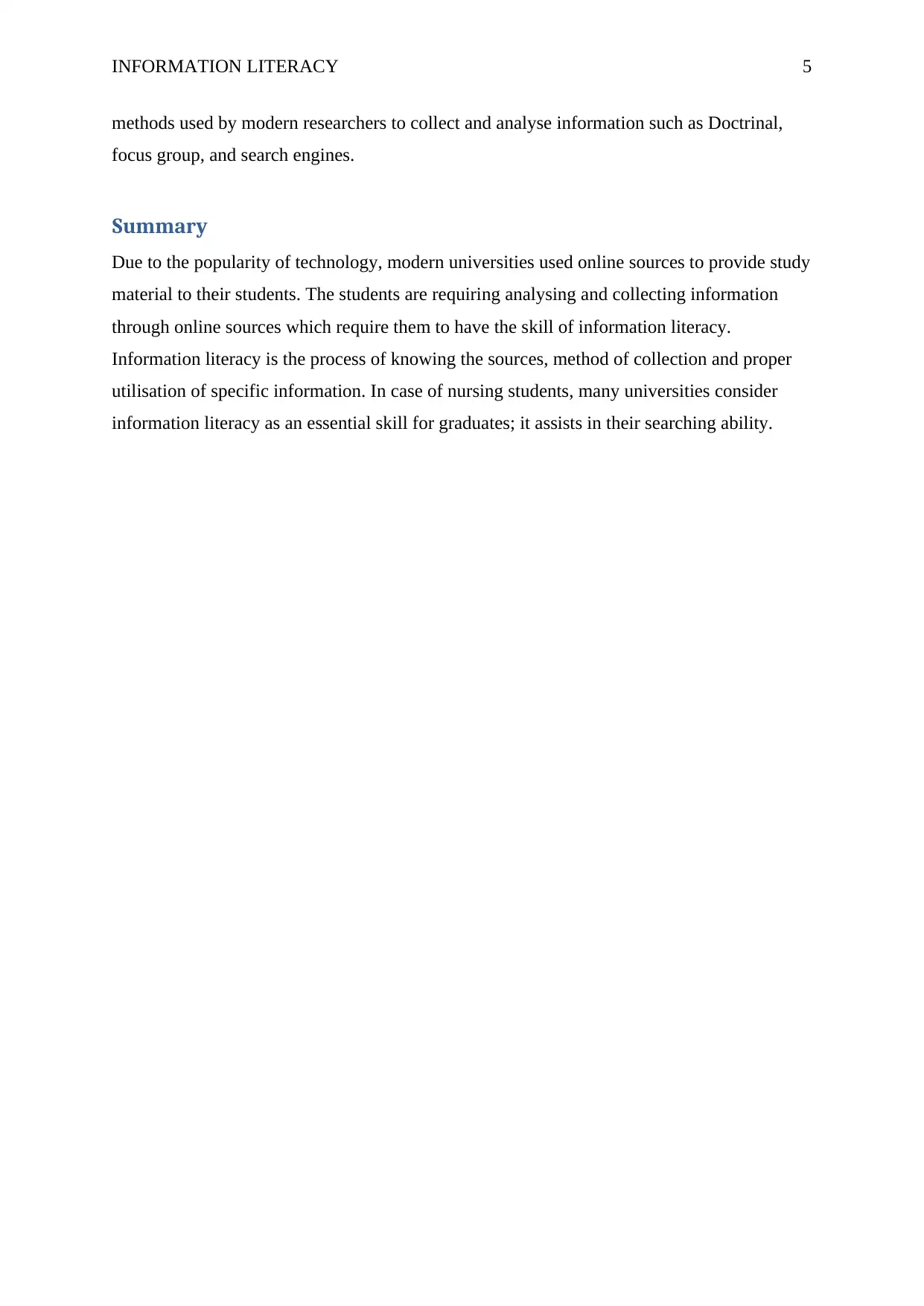
INFORMATION LITERACY 5
methods used by modern researchers to collect and analyse information such as Doctrinal,
focus group, and search engines.
Summary
Due to the popularity of technology, modern universities used online sources to provide study
material to their students. The students are requiring analysing and collecting information
through online sources which require them to have the skill of information literacy.
Information literacy is the process of knowing the sources, method of collection and proper
utilisation of specific information. In case of nursing students, many universities consider
information literacy as an essential skill for graduates; it assists in their searching ability.
methods used by modern researchers to collect and analyse information such as Doctrinal,
focus group, and search engines.
Summary
Due to the popularity of technology, modern universities used online sources to provide study
material to their students. The students are requiring analysing and collecting information
through online sources which require them to have the skill of information literacy.
Information literacy is the process of knowing the sources, method of collection and proper
utilisation of specific information. In case of nursing students, many universities consider
information literacy as an essential skill for graduates; it assists in their searching ability.
⊘ This is a preview!⊘
Do you want full access?
Subscribe today to unlock all pages.

Trusted by 1+ million students worldwide
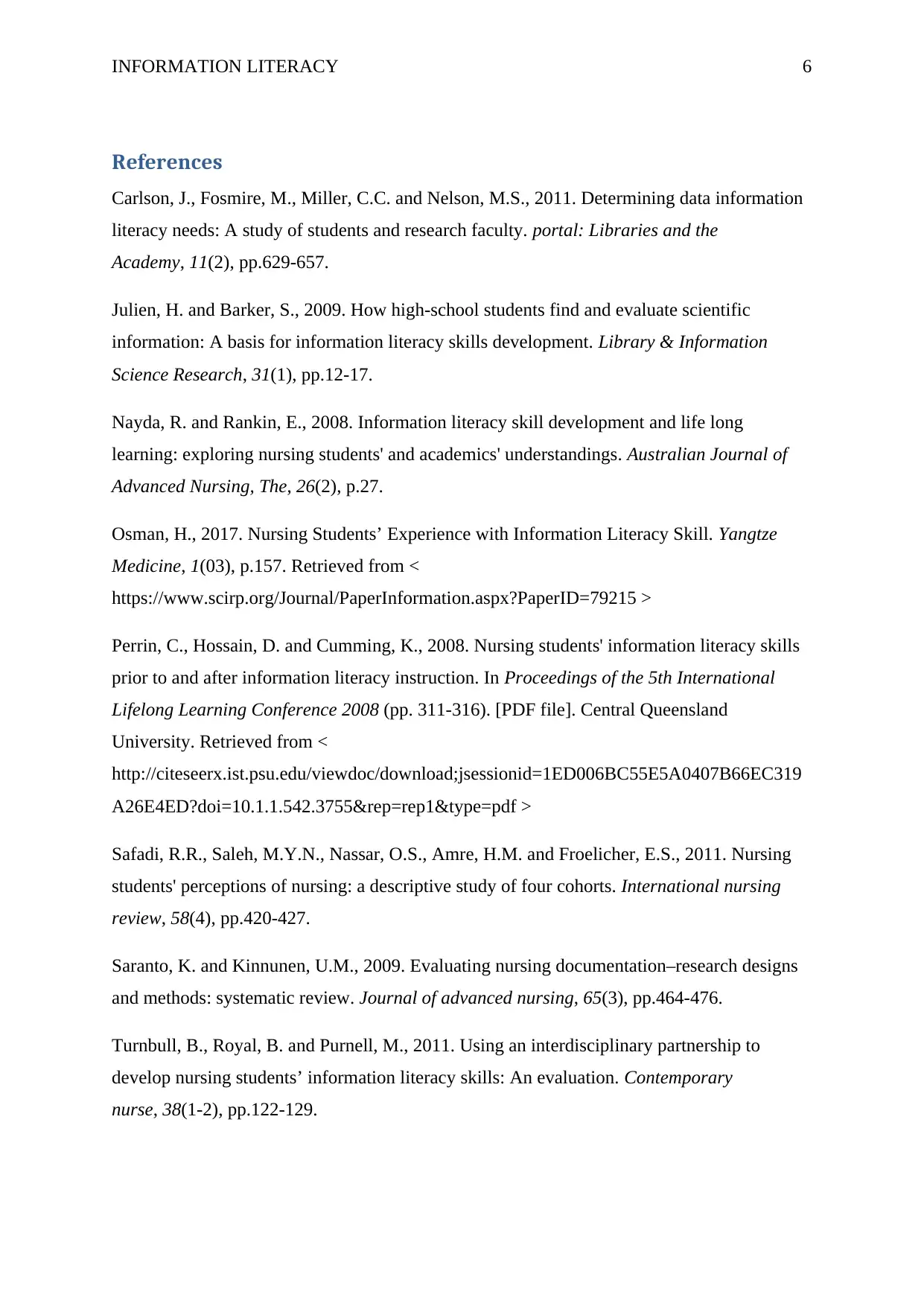
INFORMATION LITERACY 6
References
Carlson, J., Fosmire, M., Miller, C.C. and Nelson, M.S., 2011. Determining data information
literacy needs: A study of students and research faculty. portal: Libraries and the
Academy, 11(2), pp.629-657.
Julien, H. and Barker, S., 2009. How high-school students find and evaluate scientific
information: A basis for information literacy skills development. Library & Information
Science Research, 31(1), pp.12-17.
Nayda, R. and Rankin, E., 2008. Information literacy skill development and life long
learning: exploring nursing students' and academics' understandings. Australian Journal of
Advanced Nursing, The, 26(2), p.27.
Osman, H., 2017. Nursing Students’ Experience with Information Literacy Skill. Yangtze
Medicine, 1(03), p.157. Retrieved from <
https://www.scirp.org/Journal/PaperInformation.aspx?PaperID=79215 >
Perrin, C., Hossain, D. and Cumming, K., 2008. Nursing students' information literacy skills
prior to and after information literacy instruction. In Proceedings of the 5th International
Lifelong Learning Conference 2008 (pp. 311-316). [PDF file]. Central Queensland
University. Retrieved from <
http://citeseerx.ist.psu.edu/viewdoc/download;jsessionid=1ED006BC55E5A0407B66EC319
A26E4ED?doi=10.1.1.542.3755&rep=rep1&type=pdf >
Safadi, R.R., Saleh, M.Y.N., Nassar, O.S., Amre, H.M. and Froelicher, E.S., 2011. Nursing
students' perceptions of nursing: a descriptive study of four cohorts. International nursing
review, 58(4), pp.420-427.
Saranto, K. and Kinnunen, U.M., 2009. Evaluating nursing documentation–research designs
and methods: systematic review. Journal of advanced nursing, 65(3), pp.464-476.
Turnbull, B., Royal, B. and Purnell, M., 2011. Using an interdisciplinary partnership to
develop nursing students’ information literacy skills: An evaluation. Contemporary
nurse, 38(1-2), pp.122-129.
References
Carlson, J., Fosmire, M., Miller, C.C. and Nelson, M.S., 2011. Determining data information
literacy needs: A study of students and research faculty. portal: Libraries and the
Academy, 11(2), pp.629-657.
Julien, H. and Barker, S., 2009. How high-school students find and evaluate scientific
information: A basis for information literacy skills development. Library & Information
Science Research, 31(1), pp.12-17.
Nayda, R. and Rankin, E., 2008. Information literacy skill development and life long
learning: exploring nursing students' and academics' understandings. Australian Journal of
Advanced Nursing, The, 26(2), p.27.
Osman, H., 2017. Nursing Students’ Experience with Information Literacy Skill. Yangtze
Medicine, 1(03), p.157. Retrieved from <
https://www.scirp.org/Journal/PaperInformation.aspx?PaperID=79215 >
Perrin, C., Hossain, D. and Cumming, K., 2008. Nursing students' information literacy skills
prior to and after information literacy instruction. In Proceedings of the 5th International
Lifelong Learning Conference 2008 (pp. 311-316). [PDF file]. Central Queensland
University. Retrieved from <
http://citeseerx.ist.psu.edu/viewdoc/download;jsessionid=1ED006BC55E5A0407B66EC319
A26E4ED?doi=10.1.1.542.3755&rep=rep1&type=pdf >
Safadi, R.R., Saleh, M.Y.N., Nassar, O.S., Amre, H.M. and Froelicher, E.S., 2011. Nursing
students' perceptions of nursing: a descriptive study of four cohorts. International nursing
review, 58(4), pp.420-427.
Saranto, K. and Kinnunen, U.M., 2009. Evaluating nursing documentation–research designs
and methods: systematic review. Journal of advanced nursing, 65(3), pp.464-476.
Turnbull, B., Royal, B. and Purnell, M., 2011. Using an interdisciplinary partnership to
develop nursing students’ information literacy skills: An evaluation. Contemporary
nurse, 38(1-2), pp.122-129.
Paraphrase This Document
Need a fresh take? Get an instant paraphrase of this document with our AI Paraphraser
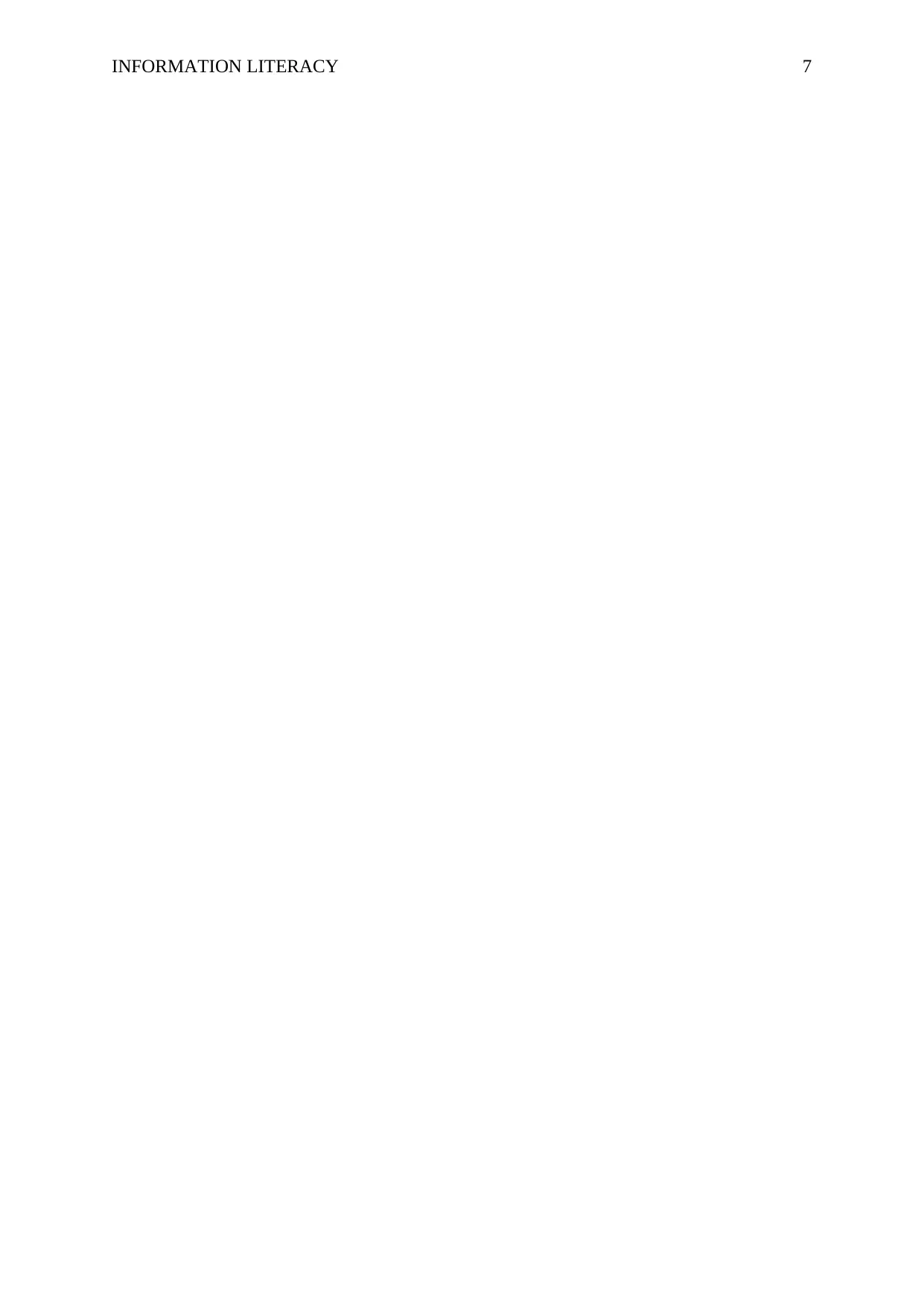
INFORMATION LITERACY 7
1 out of 8
Related Documents
Your All-in-One AI-Powered Toolkit for Academic Success.
+13062052269
info@desklib.com
Available 24*7 on WhatsApp / Email
![[object Object]](/_next/static/media/star-bottom.7253800d.svg)
Unlock your academic potential
Copyright © 2020–2025 A2Z Services. All Rights Reserved. Developed and managed by ZUCOL.





